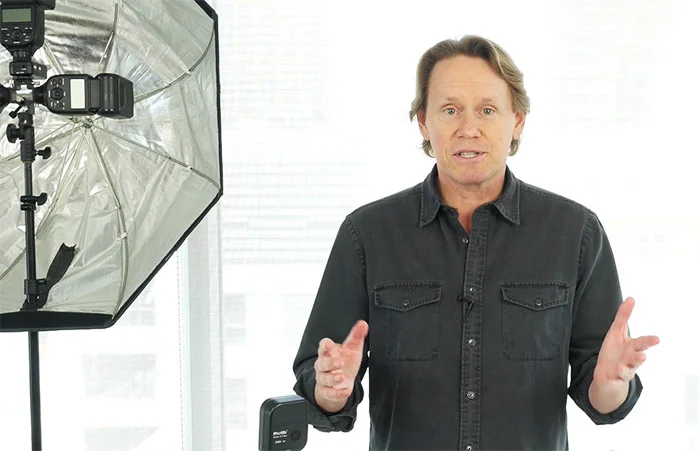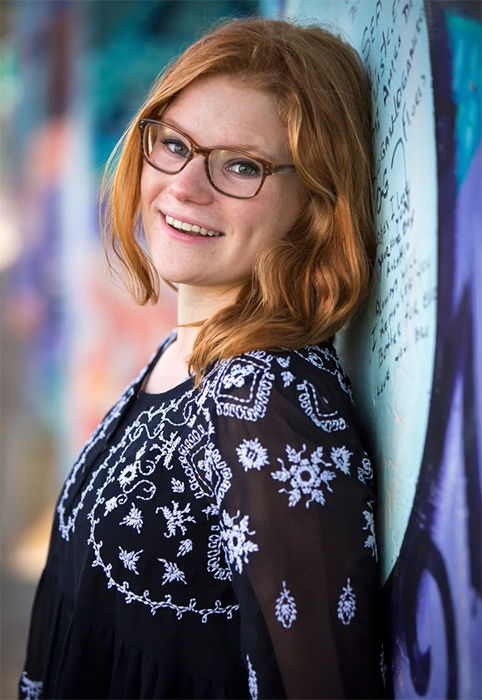Perhaps one of the signs of the accomplished photographer is being able to master off-camera flash photography. It’s so easy to look at a professional studio set-up and feel overwhelmed.
Phil Steele’s “Advanced Off-Camera Flash Photography” video course is designed to get you over that first hesitation. And then to lead you on to competence in a wide range of techniques.
If you think this might be interesting, then this review of “Advanced Off-Camera Flash Photography” is worth reading. We examine the course, its content and delivery, and what it does well or could do better. Then you can decide if it’s for you!

Phil is a professional photographer and long-time educator based in California.
His website is SteeleTraining.com. He has several courses on different fields of photography, like ‘Advanced Off-Camera Flash’.
SteeleTraining also has a popular YouTube channel. As I was watching this course, it clicked that I’ve seen him before. And indeed, his video on lens hoods has millions of views on the platform. It was released back when I started studying photography, 6-7 years ago, and I’ve learnt from it.
His style of teaching is entertaining and understandable. I do think it’s a bit too wordy and loose, but more on that later.
‘Advanced Off-Camera Flash’ actually has a prequel, ‘Professional Portraits on a Budget with Your Flash’. In preparation for this review, I’ve watched that course, too. It was Phil’s very first product, and in 2020, it’s not up to the standards. You’re better off skipping it and jumping right into ‘Advanced Off-Camera Flash’. This contains most of the knowledge from the old course.

‘Advanced Off-Camera Flash’ is roughly five hours long, which is ideal. External flash lighting is not a thing one could teach within a few minutes.
Its chapters are in two main parts: Equipment and Techniques and Photo Shoots.

Phil also added (and keeps adding) some of his free videos to ‘Advanced Off-Camera Flash’. These have been shot primarily for his YouTube channel, but are related to the content of the course.
At the time of writing, ‘Advanced Off-Camera Flash’ is available for $147. For a course of such scope, this is a competitive price.
To follow the guidance of this course, you’ll need to have a good set of accessories.
This consists of:
At the beginning of the course, Phil gives you instructions on finding all these so that they work with your camera setup.
Keep in mind that they can cost you anything between a few hundred to a few thousand USD, but usually closer to the low end.
Let’s see the reasons why I recommend this course.
The course is long, and it’s filled with valuable content. Phil shows multiple sorts of photoshoots in high detail. He is very accurate in teaching lighting and modifying light.
For example, in the headshot section, we can see the process from the very beginning right until exporting the final images. You can learn much of Phil’s workflow for photographing with flashes in this course.
There is even a video explaining the mistakes he made during that photoshoot. While some of them are really amateurish (like forgetting to shoot in RAW), I appreciate him including the episode in the course. For inexperienced photographers, that video holds great value. They won’t commit the same mistakes.
Even if you have plenty of experience in photography, it might be worth checking the course out. It’s full of great ideas in terms of lighting and compositions.
For instance, it shows you how to shoot professional-looking images in bright sunlight and what to look for in this situation. I’ve done this particular type of shoot before, with moderate success (it’s not something I exercise very often).
If I’d watched this video before, my results would have been better, and I’d have been more careful.
‘Advanced Off-Camera Flash’ is a well-built product. It covers everything you need to work in this field, even professionally.
Of course, there’s always room for improving yourself and learning more. But you get a very solid base, from where you’ll know where and how to continue.
You’ll learn how to replicate natural light in a flash environment, and how to backlight your subjects to make them pop. It also covers how to add a handheld flash in event photography.
The mindset you’ll get will change the way you think about lighting and light. Not limited by your single flash or natural light, your possibilities extend much further.
Many instructors use and recommend expensive and often excessive first-party equipment. But in the recent decade, many third-party brands emerged. Especially in the field of external flashes, triggers, and modifiers. They now offer high-quality gear for much cheaper.
I use a set of Godox flashes (and triggers), and they rival Canon flashes that cost triple that, in most aspects.
Phil talks a lot about this, and I find it very practical advice. He’ll teach you what and why to look for in your accessories. He knows well that you probably won’t need the “best” gear available. He himself works with cheaper alternatives on occasions, too.
Phil states on his website: “Isn’t it funny how you can spot pro-caliber photos? They stand out. They pop in some special way.”
I agree with this. A well-thought-out flash setup with modifiers can make the illusion that a subject is lit with only natural light. But to achieve this effect, you have to be careful and attentive.
The results in the course speak for themselves. In the course, you can learn how to replicate this pro-caliber look.

Now, let’s see what I think the lacking areas are.
The first and most serious problem with this course is the quality of production. Out of Phil’s five courses, this one is the newest, best and most advanced. Its production is far better compared to his older ones (especially the older flash course).
Yet, video and sound quality still leave much to be desired.
The course is available in 1080P (FullHD) resolution on the website. However, it quite looks like as it was shot at a lower setting and upscaled during editing. I have the same camera that Phil used for recording (Canon 5D MkIII), and I know it’s capable of better. The issue is especially pronounced in outdoor episodes.
The video side is also subpar in terms of lighting and composition. It’s enough to show what’s happening in the scene – but the quality is not so pleasing. This is especially true in an age when you don’t need a cinema camera and a full crew to produce professional quality.
Sound quality is good enough in outdoor scenes. In the studio scenes, it’s quite noisy and reverby.
It seems that Phil has produced this course almost all by himself. Having a professional videographer shoot and edit the course so Phil could concentrate on the contents would have benefited it a lot.
While there are no problems with the content generally, there is one episode that I didn’t enjoy. It’s the Retouch episode from the Headshot series, particularly the section when Phil works in Photoshop. It’s by far the longest episode of the course, at 52 minutes.
In the video, Phil did almost all of his edits destructively. This means that he worked mostly on a single layer, and for a short part on one additional. This approach results in your modifications baked into the image. If you want to correct something, you need to press ‘Undo’ until you get back that step. If you’ve done 20 minutes of work since then, you have to discard all of that to correct one mistake.
Working on separate layers in Photoshop is the superior approach. You need to make new layers for different stages of retouching, to manipulate or edit them independently. Or, to correct mistakes on one layer, without affecting all the others. This saves you an immense amount of anger and time in the long run.
You will acquire a lot of knowledge from ‘Advanced Off-Camera Flash’, that’s for sure.
But, I often felt that Phil repeated himself often. On the one hand, this is good for learning. New stuff sticks better if it’s repeated. On the other hand, this extends the length of the course quite a bit. You can go back and rewatch anytime – so I would have made the points a little shorter.
The same is true for video editing. The scenes are loosely edited together, but there are unnecessarily long cuts.
It’s good for showing the real-time progress of a shoot or retouching. I would prefer to have the content edited more densely, with a higher information-to-duration ratio. It would also make sense to include a ‘playing speed’ option on the website. People would be able to browse through the course faster.
There is a strong alternative to ‘Advanced Off-Camera Flash’ by Phil Steele.
Ironically, it’s also called ‘Advanced Off-Camera Flash’ by SLRLounge. I have yet to review their products, but it seems that they offer professionally produced, high-quality tutorials.
Their off-camera flash course is aimed more towards pros or experienced amateurs. It doesn’t have all the introductory lessons Phil’s course has. In turn, there is much more advanced content in there. It’s available at $149, which is almost identical to Phil’s. So, the choice only depends on your preferences.
Phil Steele’s best and newest course on ‘Advanced Off-Camera Flash’ is a well-thought-out course. It is aimed towards aspiring amateurs.
If you want to broaden your photography skill set with something completely new, it’s definitely worth checking it out. The course will safely bring you to a high-medium level in flash lighting.
Have a look at it on Phil’s website here.
To standardise and compare our product reviews, we’ve decided to use a scored-based ranking system. To learn more about interpreting these numbers and how other courses measure, please visit our review roundup page here.
| Measurement |
Measurement
Score
|
| Coverage |
Coverage
|
| Accuracy |
Accuracy
|
| Ease of Learning |
Ease of Learning
|
| Production Value |
Production Value
|
| Uniqueness |
Uniqueness
|
| Community and Learning Support |
Community and Learning Support
|
| Value for Money |
Value for Money
|
| Total Score |
Total Score
|

